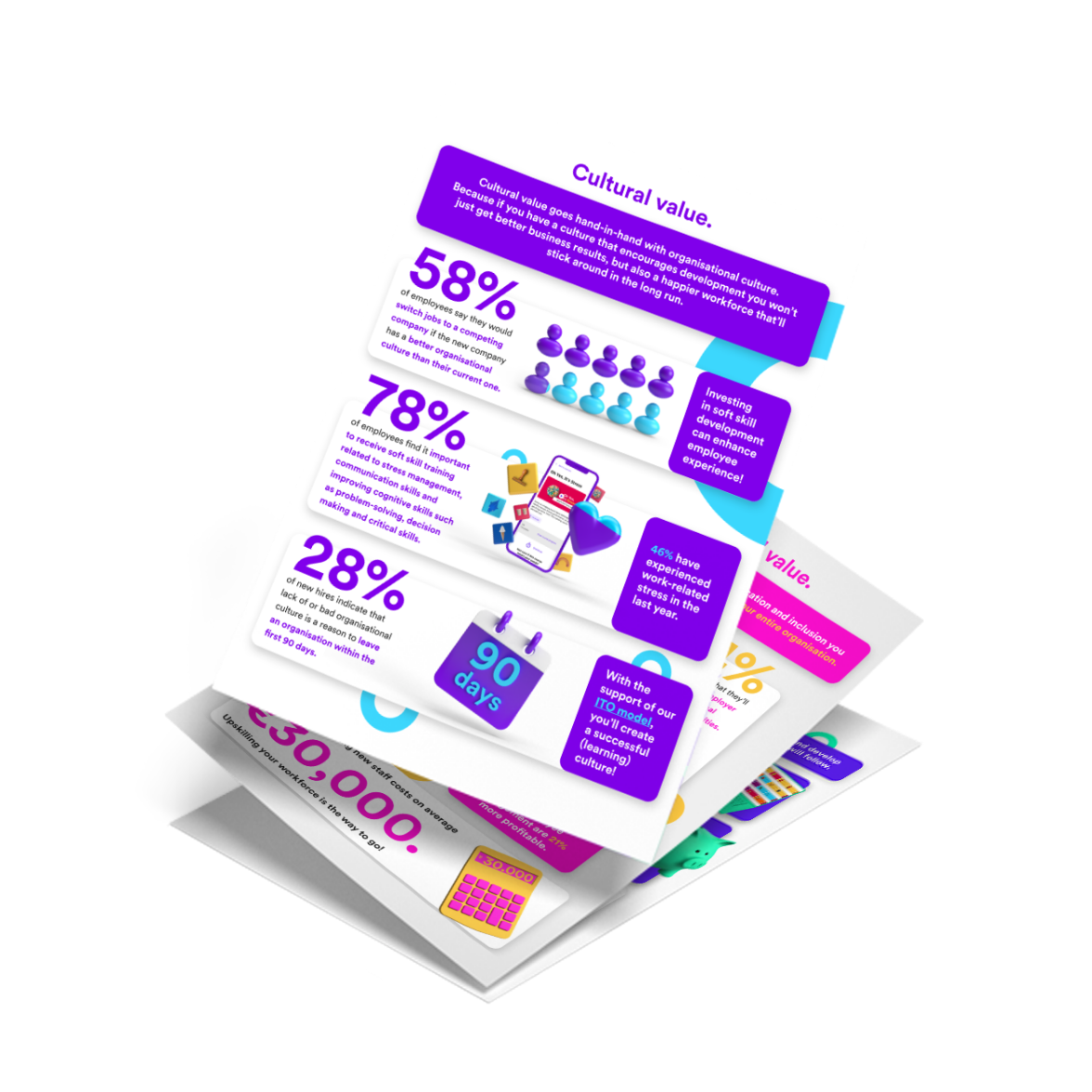
Think future growth, act now on L&D.
Turbulent times shouldn’t call for turbulent measures. When budgets need a second look, Learning and Development costs will become an easy target. If your manager is thinking of cutting your L&D budget to minimise costs – they should think again! While careful cost management is always essential, it’s having access to the right people and the right skills that will carry a company through tough times. In this blog post, we’ll give you the tools to convince your manager, in the form of 10 reasons and several client proofpoints, on why your business needs to continue investing in your people through L&D - or start doing so right this second.

Dive into the following arguments:
- How L&D can improve ROI.
- L&D leads to increased employee engagement.
- The art of saving money is called upskilling!
- The flexibility of online learning.
- Attracting (and retaining) the next generation of talent.
- Today's professionals expect L&D opportunities.
- The skills landscape is changing at a record pace.
- It's time to act, not react!
- The positive effects of supporting neurodiversity.
- The growing focus on soft skills and mental health.
Reason #1: How L&D can improve ROI.
The more you invest in L&D, especially online learning, the more you are likely to be rewarded, with a total of 42% of companies seeing an increase in profits after investing in digital learning. According to the same IBM study, every euro invested in online training results in €30 in productivity, mainly because employees are able to carry out their work faster and apply their new skills immediately. Knowing all this, do your employees have sufficient access to development opportunities? And how do you make your business case internally? At GoodHabitz, we believe in spending a small percentage (5% to 10%) of your personal development budget on 100% of your employees. Even if you spend only a fraction of your budget to train the entire organisation in soft skills, you will see an overall increase in business performance! Imagine if your workforce learns to communicate more efficiently, knows how to lead teams or becomes digitally savvy. All of this and more will result in organisational growth and an increase in profit. To find out more about measuring the return (ROI) of online learning, check out our blog.
‘’With GoodHabitz, through a promotion, Nippon Express saw a whopping 90% increase in the number of class visits compared to the previous months!’’ - Ken van Egmond, Logistics Manager at Nippon Express.
Reason #2: Money can’t buy you happiness, but it can buy you L&D.
…which will lead to increased employee engagement. Which is pretty much the same thing. 😉 Employee engagement, the involvement and enthusiasm of employees in their work and workplace, is (or should be) one of the foundations of your HR strategy. According to AON, engaged employees deliver more value to their company. Engaged employees are more likely to stay with a company, speak positively about their job and strive for success. Leading to increased productivity and lower employee turnover.
‘’GoodHabitz saves us additional costs annually with external trainers. But we have also achieved great results in terms of the personal development of our employees. For instance, one of our targets was to have 50% of our employees familiar with GoodHabitz within three months. We more than achieved this at 73%.’’ - DEKRA.
Reason #3: The art of saving money is called up-skilling!
A lack of personal development opportunities has become a significant reason why professionals leave their jobs. McKinsey research found that ‘’a primary driver of quitting is that employees do not have opportunities to learn new things or find their work interesting or challenging.’’ If stagnation and a lack of opportunity send your team members searching for better opportunities, the cost of recruiting and rehiring for their roles (on average around £30,000) far outweighs most investments you could have made into their development and training. It is also crucial to focus on upskilling during times of economic downturn because, much like building your savings and paying down debts, it creates a solid foundation for stability and growth.
‘’We are at a time when it is difficult to find good talent outside of your company. We must prepare our teams to grow with us.’’ - Cristina Kiskeri, Head of Talent at Ferrer.
Reason #4: The flexibility of online learning.
We’ve already mentioned the rising demand for learning and development. But how do you tackle that in today’s hybridised on-site and remote work environment? Online learning offers far more flexibility than traditional in-person learning. Your employees will have the freedom to not only choose when and where they want to focus on their personal development, but also which way suits them best. Empowering employees to develop themselves in their preferred way has tons of benefits for your company. If someone can choose the way in which they want to develop themselves, they are more likely to do so. This article further delves into stimulating personal development for a remote workforce.
‘’There are competitors in the market that offer only videos. GoodHabitz, on the other hand, has an innovative and diverse mix of learning methods, WorkOuts, animated videos and other tools that are modern, engaging and fun. That makes GoodHabitz a perfect match for us.’’ - Holger Ucher, Digital Learning Manager at Viking.

Reason #5: Attracting (and retaining) the next generation of talent.
You want to remain a future-proof organisation, right? Well, attracting and retaining the right talent should be at the top of your agenda! A report by Hays found that Gen Y employees (1981 – 1994) take their personal development very seriously. When deciding on a potential employer, 53% put ‘training and development’ atop of their list of decision-making factors. This means that companies offering quality L&D programs (*ahem* like our online training courses *ahem*) are more likely to attract talented and ambitious young people.
‘’Especially for young and inexperienced managers, topics like leadership, teamwork and coaching management offer a great basis.’’ - Birgit Gutwald, Human Resources Development at Hans im Glück.
Reason #6: Today’s professionals expect L&D opportunities.
Remember that time when learning and career development programs were considered a luxury perk? We don’t either! Today’s professionals expect their employers to support their (professional) development. This is something that is underestimated by employees, as told in our blog post. Additionally, an overwhelming 94% of professionals told LinkedIn that they would stay at a company longer if it invested in their careers and personal development. Convinced yet?
GoodHabitz is for the happy everyone! Meaning that your entire workforce gets access to our complete course library. Read more.
Reason #7: The skills landscape is changing at a record pace.
The qualities that professionals and their organisations need to survive and thrive are very different from those in the past. Historically, the success of a business heavily relied on technical skills, but times are changing! In recent research by Deloitte, today's success is increasingly dependent on soft and digital skills. The same study shows that professionals identify their employer as the primary entity responsible for their development, even outranking themselves. So, it’s your move! And trust us, this goes way further than office jobs. Manual workers duties now include supporting and using technology, which requires a certain level of digital skill. So where should someone acquire those skills? Through e-learning! According to a survey undertaken by Wellms.io, 50% of companies surveyed declared that there are employee groups within the organisation with insufficient or non-existent access to e-learning. These groups included retail jobs, physical workers, and technicians. Want to read more? We have an entire blog dedicated to different learning needs and taking these into account, check it out here.
Check out our digital skills courses
Reason #8: It’s time to act, not react!
An economic downturn typically lasts between 6 to 12 months. But, as we like to focus on the bright side: this period of decline will, at some point, be followed by a period of growth! By putting less focus on L&D during slower times, your business will find itself playing catch-up once the economy inevitably turns.
‘’GoodHabitz has allowed us to bridge the (skills) gaps highlighted by our teams with ad hoc training. Always clear, interesting, comprehensive and never boring!’’ - Antonio Zipete, Learning Manager at Miscusi restaurants.
Reason #9: The positive effects of supporting neurodiversity.
Estimates find that about 18% of the population has neurodiverse learning needs. Neurodiversity includes a range of conditions like dyslexia, ADHD and autism. To properly support neurodiversity and ensure a secure, accessible learning environment for everyone, a company should view L&D as a ‘must have’, instead of a ‘nice to have’. Turns out, that organisations which actively support neurodiversity have very positive business results! Need an example? A study by SAP found that teams with neurodiverse colleagues report a rise in innovations in products and an increase in management skills and empathy. Also, teams with neurodivergent professionals can be 30% more productive than those without, as stated by Deloitte. By supporting neurodiversity, businesses create learning environments that are more understanding, innovative and inclusive, that encompass the spectrum of human experiences and perspectives. Lastly, it doesn’t only bring increased diversity in skills, ways of thinking and approaches to problem-solving, but can also turn the tide on the current labour shortage. Here we elaborate further on the importance of diversity and inclusion in the workplace.
‘’The multi-format and multi-channel methodology of GoodHabitz makes it possible to reach all profiles, depending on their way of assimilating concepts.’’ - BNP Paribas.
Reason #10: The growing focus on soft skills and mental health.
From 2020 onwards, mental health support at work went from a nice-to-have, to being business imperative. Developing your soft skills goes hand-in-hand with strong mental wellbeing – which gives companies another angle to proactively address mental health at work. Epignosis survey states that 78% of employees find it important that they receive skills training. A few that are coming to the forefront are: stress management, effective communication and improving cognitive skills such as problem-solving, decision making and critical and creative thinking. But the value goes way further than benefitting the employee. WHO states that every euro invested in the treatment of common mental disorders like depression and anxiety, see a return of €5,20 in terms of improved health and productivity. An EU survey reveals that workplace stress is on the rise: 46% of respondents say that they are exposed to severe time pressure or work overload. On a positive note, the same study states that talking about mental health is no longer taboo: 59% of workers say they feel comfortable speaking to their manager about mental health. However, 50% still worry about disclosing a mental health condition, as they think it can have a negative effect on their career. Our online library is filled with training courses focused on wellbeing: ranging from Bye-Bye Burnout, Mind Your Brain to Oh Yes, It’s Stress.
‘’We believe that the acquisition of soft skills and personal well-being outside of work makes employees happy and high performing.’’ - Silvia Mancuso, Talent Manager at FIEGE.
Hungry for more? We got you! Read this article on the importance of soft skills and get the full scoop in our L&D Challenges & Solutions article.





